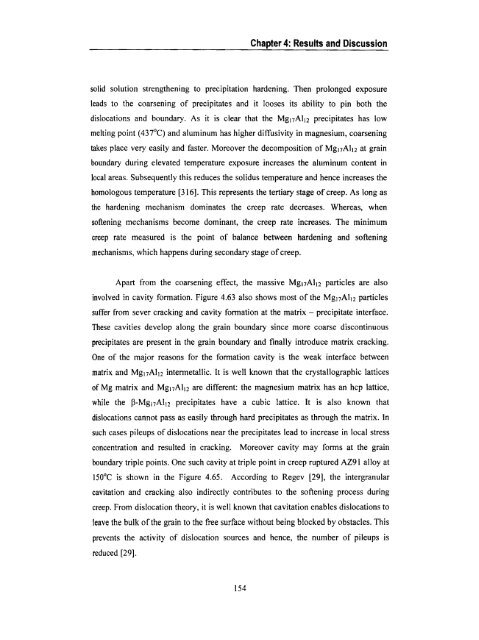“Influence of Si, Sb and Sr Additions on the Microstructure ...
“Influence of Si, Sb and Sr Additions on the Microstructure ...
“Influence of Si, Sb and Sr Additions on the Microstructure ...
You also want an ePaper? Increase the reach of your titles
YUMPU automatically turns print PDFs into web optimized ePapers that Google loves.
Chapter 4: Results <str<strong>on</strong>g>and</str<strong>on</strong>g> Discussi<strong>on</strong><br />
solid soluti<strong>on</strong> streng<strong>the</strong>ning to precipitati<strong>on</strong> hardening. Then prol<strong>on</strong>ged exposure<br />
leads to <strong>the</strong> coarsening <str<strong>on</strong>g>of</str<strong>on</strong>g> precipitates <str<strong>on</strong>g>and</str<strong>on</strong>g> it looses its ability to pin both <strong>the</strong><br />
dislocati<strong>on</strong>s <str<strong>on</strong>g>and</str<strong>on</strong>g> boundary. As it is clear that <strong>the</strong> Mg17Al12 precipitates has low<br />
melting point (43 7°C) <str<strong>on</strong>g>and</str<strong>on</strong>g> aluminum has higher diffusivity in magnesium, coarsening<br />
takes place very easily <str<strong>on</strong>g>and</str<strong>on</strong>g> faster. Moreover <strong>the</strong> decompositi<strong>on</strong> <str<strong>on</strong>g>of</str<strong>on</strong>g> Mg;7Al|; at grain<br />
boundary during elevated temperature exposure increases <strong>the</strong> aluminum c<strong>on</strong>tent in<br />
local areas. Subsequently this reduces <strong>the</strong> solidus temperature <str<strong>on</strong>g>and</str<strong>on</strong>g> hence increases <strong>the</strong><br />
homologous temperature [3l6]. This represents <strong>the</strong> tertiary stage <str<strong>on</strong>g>of</str<strong>on</strong>g> creep. As l<strong>on</strong>g as<br />
<strong>the</strong> hardening mechanism dominates <strong>the</strong> creep rate decreases. Whereas, when<br />
s<str<strong>on</strong>g>of</str<strong>on</strong>g>tening mechanisms become dominant, <strong>the</strong> creep rate increases. The minimum<br />
creep rate measured is <strong>the</strong> point <str<strong>on</strong>g>of</str<strong>on</strong>g> balance between hardening <str<strong>on</strong>g>and</str<strong>on</strong>g> s<str<strong>on</strong>g>of</str<strong>on</strong>g>tening<br />
mechanisms, which happens during sec<strong>on</strong>dary stage <str<strong>on</strong>g>of</str<strong>on</strong>g> creep.<br />
Apart from <strong>the</strong> coarsening effect, <strong>the</strong> massive Mg|-,Al12 particles are also<br />
involved in cavity formati<strong>on</strong>. Figure 4.63 also shows most <str<strong>on</strong>g>of</str<strong>on</strong>g> <strong>the</strong> Mg]-;Al1;> particles<br />
suffer from sever cracking <str<strong>on</strong>g>and</str<strong>on</strong>g> cavity formati<strong>on</strong> at <strong>the</strong> matrix — precipitate interface.<br />
These cavities develop al<strong>on</strong>g <strong>the</strong> grain boundary since more coarse disc<strong>on</strong>tinuous<br />
precipitates are present in <strong>the</strong> grain boundary <str<strong>on</strong>g>and</str<strong>on</strong>g> finally introduce matrix cracking.<br />
One <str<strong>on</strong>g>of</str<strong>on</strong>g> <strong>the</strong> major reas<strong>on</strong>s for <strong>the</strong> formati<strong>on</strong> cavity is <strong>the</strong> weak interface between<br />
matrix <str<strong>on</strong>g>and</str<strong>on</strong>g> Mg17Al12 intermetallic. It is well known that <strong>the</strong> crystallographic lattices<br />
<str<strong>on</strong>g>of</str<strong>on</strong>g> Mg matrix <str<strong>on</strong>g>and</str<strong>on</strong>g> Mg17Al|2 are different: <strong>the</strong> magnesium matrix has an hcp lattice,<br />
while <strong>the</strong> |3-MgnAl12 precipitates have a cubic lattice. It is also known that<br />
dislocati<strong>on</strong>s cannot pass as easily through hard precipitates as through <strong>the</strong> matrix. ln<br />
such cases pileups <str<strong>on</strong>g>of</str<strong>on</strong>g> dislocati<strong>on</strong>s near <strong>the</strong> precipitates lead to increase in local stress<br />
c<strong>on</strong>centrati<strong>on</strong> <str<strong>on</strong>g>and</str<strong>on</strong>g> resulted in cracking. Moreover cavity may forms at <strong>the</strong> grain<br />
boundary triple points. One such cavity at triple point in creep ruptured AZ91 alloy at<br />
150°C is shown in <strong>the</strong> Figure 4.65. According to Regev [29], <strong>the</strong> intergranular<br />
cavitati<strong>on</strong> <str<strong>on</strong>g>and</str<strong>on</strong>g> cracking also indirectly c<strong>on</strong>tributes to <strong>the</strong> s<str<strong>on</strong>g>of</str<strong>on</strong>g>tening process during<br />
creep. From dislocati<strong>on</strong> <strong>the</strong>ory, it is well known that cavitati<strong>on</strong> enables dislocati<strong>on</strong>s to<br />
leave <strong>the</strong> bulk <str<strong>on</strong>g>of</str<strong>on</strong>g> <strong>the</strong> grain to <strong>the</strong> free surface without being blocked by obstacles. This<br />
prevents <strong>the</strong> activity <str<strong>on</strong>g>of</str<strong>on</strong>g> dislocati<strong>on</strong> sources <str<strong>on</strong>g>and</str<strong>on</strong>g> hence, <strong>the</strong> number <str<strong>on</strong>g>of</str<strong>on</strong>g> pileups is<br />
reduced [29].<br />
154
















